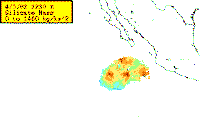El Chichon: Radiannet Examples
The 1982 El Chichon eruption provides a good example of a retrieval
for clouds with high optical depth (eg. April 4 image), and how the input
parameters need to be changed for the model as the optical thickness
(eg. April 5 image) declines. To view a complete set of AVHRR images
of El Chichon click here.
April 4, 1982 at 2102 Z: Eruptions at 01:39 and 11:10 Z
The band 4 image shows a large volcanic cloud extending over southern Mexico,
northern Guatemala and Belize. The band 4-5 image "pulls out" much more of
the cloud over western Mexico, but does not detect the optically thicker
regions of the cloud over the Yucatan.
AVHRR Band 4 image (left) and Band 4-5 image (right).
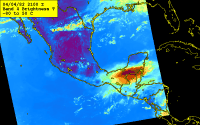
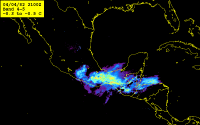
Radiannet Plots
These plots are generated by Radiannet, using the input parameters
specified by the user, and are used to evaluate if the appropriate
parameters were choosen. Click here
for a discription of the plots generated by Radiannet.
The plot on the left is the Radius-Optical depth plot for the image
shown above. The red dots are the actual AVHRR pixel values for the cloud, the
solid lines are theoretical effective radius values and the dashed lines are
theoretical optical depth values. Note that the cloud has a wide range of
optical depths, and that the AVHRR values fit well inside the Radius-Optical
Depth envelope constructed using the input conditions. (See below for input
values). The plot on the right is the range of effective radius values
that can be retrieved using the input values. It shows that particles with
an effective radius of 2.4 to 11.94 microns can be retrieved. Values less
than 2.4 microns cannot be retrieved uniquely. In this case, this is not a
problem since the Radius-Optical depth plot shows that most of the points
fall inside the 2.4 to 11.94 envelope.
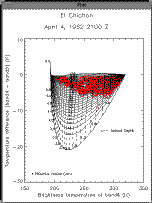

Input parameters and output values
Execution Date . . . . . . Tue Mar 28 14:05:51 EST 1995
Input Data File Name . . . ascii.094.2102
Plot Title . . . . . . . . El Chichon
Plot Sub Title . . . . . . April 4, 1982 2100 Z
Theoretical Particle Size Distribution . . . . Lognormal
The Scale of the Mass Retrieval . . . . . . . . Frame Scale Retrieval
Reflective Index Material . . . . . . . . . . . Andesite
Minimum Effective Radius (um) . . . . . . . . . . . . . 2.40000
Maximum Effective Radius (um) . . . . . . . . . . . . . 12.00000
Cloud-Top Temperature (k) . . . . . . . . . . . . . . . 193.00000
Cloud-Base Temperature (k) . . . . . . . . . . . . . . 320.00000
X Image Dimension . . . . . . . . . . . . . . . . . . . 4700.00000
Y Image Dimension . . . . . . . . . . . . . . . . . . . 10.00000
Pixel Area (km^2) . . . . . . . . . . . . . . . . . . . 25.00000
Delta X . . . . . . . . . . . . . . . . . . . . . . . . 0.20000
Band4 - Band5 Maximum Cutoff Value . . . . . . . . . . -0.50000
Number of Horizontal Lines . . . . . . . . . . . . . . 30.00000
Number of Radii Lines . . . . . . . . . . . . . . . . 30.00000
Total Number of Volcanic Pixels . . . . . . . . . . . . 24676.00000
Mean Effective Radius (um) . . . . . . . . . . . . . . 8.56685
Mean Optical Depth of Volcanic Pixels . . . . . . . . . 1.27318
Mean Volcanic Pixel Mass (MT) . . . . . . . . . . . . . 342.03000
Total Volcanic Cloud Mass (MT) . . . . . . . . . . . . 8439930.00000
Map of Silicate Mass Retrieval
The following image is a map of the mass retrieval using the parameters
shown above. In this case, the output values were ingested into Terascan
and mapped to the same projection as the AVHRR data. Note that the
region of maximum mass does not correspond to the maximum band 4-5
signal. As you can see in the scatter plot above, pixel with high optical
depth (and therefore high mass), have small band 4-5 values, and that the
maximum temperature difference occurs at an optical depth of about 2.0.
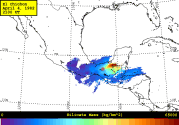
April 5, 1982 at 2230 Z
In the band 4 image, it is very difficult to discriminate the optically
thin volcanic cloud from the meterological clouds. However, it is
detected using the band 4-5 technique.
Band 4 image (left) and band 4-5 image (right).
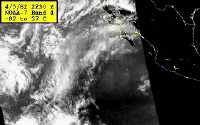
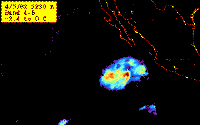
Radiannet Plots
The plots below illustrate how the input parameters need to be changed
to produce an accurate retrieval for an optically thin cloud. The
plot on the left was produced the same Delta X (ie. optical depth)
value of 0.2 as the case above for an optically thick cloud.
While the curves that are produced using these values are smooth,
and the AVHRR data plot within the evelope, note that none of the
optical depth lines intersect the AVHRR data. In this case, the values
would all be assigned to the same optical depth value of 0.2, which is
not very realistic. A better choice for the Delta X value would be 0.02.
The results of this are shown in the plot on the right. Even though
this produces curves which are not very smooth, notice that there are
many more optical depth lines which intersect the AVHRR data. The parameters
used to generate this plot are listed below.
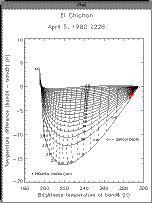

Input parameters and output values
Execution Date . . . . . . Thu Mar 23 15:23:53 EST 1995
Input Data File Name . . . ascii.095.2228
Plot Title . . . . . . . . El Chichon
Plot Sub Title . . . . . . April 5, 1982 2228
Theoretical Particle Size Distribution . . . . Lognormal
The Scale of the Mass Retrieval . . . . . . . . Frame Scale Retrieval
Reflective Index Material . . . . . . . . . . . Andesite
Minimum Effective Radius (um) . . . . . . . . . . . . . 2.40000
Maximum Effective Radius (um) . . . . . . . . . . . . . 12.00000
Cloud-Top Temperature (k) . . . . . . . . . . . . . . . 195.00000
Cloud-Base Temperature (k) . . . . . . . . . . . . . . 295.00000
X Image Dimension . . . . . . . . . . . . . . . . . . . 1091.00000
Y Image Dimension . . . . . . . . . . . . . . . . . . . 40.00000
Pixel Area (km^2) . . . . . . . . . . . . . . . . . . . 25.00000
Delta X . . . . . . . . . . . . . . . . . . . . . . . . 0.02000
Band4 - Band5 Cutoff Value . . . . . . . . . . . . . . 0.00000
Number of Horizontal Lines . . . . . . . . . . . . . . 50.00000
Number of Radii Lines . . . . . . . . . . . . . . . . 20.00000
Total Pixel Units . . . . . . . . . . . . . . . . . . . 17290.00000
Mean Effective Radius (um) . . . . . . . . . . . . . . 5.78157
Mean Optical Depth . . . . . . . . . . . . . . . . . . 0.43525
Mean Pixel Mass (MT) . . . . . . . . . . . . . . . . . 21.49740
Total Cloud Mass (MT) . . . . . . . . . . . . . . . . . 371690.00000
Map of Silicate Mass Retrieval
The following image is a map of the mass retrieval using the parameters
shown above. Note that in this case, the regions of high mass correspond
closely with the regions of large band 4-5 temperature difference.
